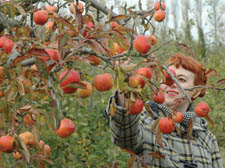|
|
 |
| |
When it comes to the crunch, English is the apple of our eye
With expensive imports and urban scrumping back in fashion, Tom Moggach says the time is ripe to grow and eat our native fruit
ENGLISH apples deserve better. For far too long, we’ve been reaching for imported fruit on shop shelves.
Growers ripped up their orchards in dismay. We forgot that English apples, gently ripening in our temperate climate, boast a flavour that’s second to none.
Thankfully, things are looking up. There’s been a bumper crop of Apple Days this year– community celebrations of the apple season.
On Sunday, for example, I helped out at the Maiden Lane estate, off Agar Grove – they have their own apple orchard out the back.
In the shops, sales of English apples are rising. Urban scrumping is back in fashion, with people harvesting free fruit from neglected trees around their neighbourhood.
But, let’s face it – there’s still a steep mountain to climb. My local Tesco, for example, devotes just a third of their shelf space to English apples at the height of their season. (Sainsbury’s and Morrisons do a much better job.)
Choice is also poor – around 2,300 apple varieties have been grown in Britain. And kids rarely get a chance to pick ripe fruit straight from the tree.
So what can we do? First, don’t give up on the idea of growing your own – there are plenty of options.
If you live on an estate, the council may help plant orchards if there is a suitable patch of land. Rustle up a group of like-minded, keen residents and get in touch (details below). I can point you in the right direction.
For a balcony or patio, look into “ballerina”, or “minarette” apple trees – compact trees in tubs that reach about seven feet tall. Some include two varieties of apple grafted onto one vertical stem.
For small gardens, a “family” tree will incorporate three varieties of apple that ripen in succession. Try fruit nurseries such as Ken Muir (www.kenmuir.co.uk) and Blackmoor (www.blackmoor.co. uk). Otherwise, just hunt out unusual apple varieties to eat. Farmers’ markets are a good bet.
Or, for free fruit, keep your eyes open for neglected fruit trees – you’ll be surprised how many you spot.
Obviously ask for permission first if the fruit tree is in a private garden. Abundance, a project in Sheffield, has published a free handbook with other practical advice
().
In Belsize Park, a group called Transition Belsize has been mapping all their local fruit trees and welcomes committed volunteers for the project
().
Don’t forget, the English apple season lasts longer these days.
Late maturing modern varieties such as Cameo, Jazz and Kanzi are now available until May – so you still have six months to enjoy this splendid fruit.
• |
 |
|
|
 |

|
|
 |
|









